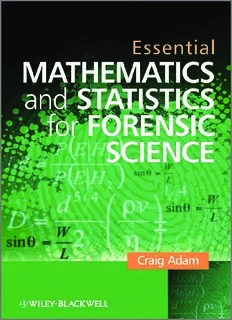
Essential Mathematics and Statistics for Forensic Science PDF
Preview Essential Mathematics and Statistics for Forensic Science
Essential Mathematics and Statistics for Forensic Science Essential Mathematics and Statistics for Forensic Science Craig Adam School of Physical and Geographical Sciences Keele University, Keele, UK A John Wiley & Sons, Ltd., Publication Thiseditionfirstpublished2010,(cid:1)c 2010byJohnWiley&SonsLtd. Wiley-Blackwellisanimprint ofJohnWiley&Sons,formed bythemergerofWiley’sglobal Scientific,Technical andMedicalbusinesswithBlackwellPublishing. Registeredoffice: JohnWiley&SonsLtd,TheAtrium,SouthernGate,Chichester,WestSussex,PO198SQ,UK OtherEditorialOffices: 9600GarsingtonRoad,Oxford,OX42DQ,UK 111RiverStreet,Hoboken,NJ07030-5774,USA Fordetailsofourglobaleditorialoffices,forcustomerservicesandforinformationabouthowtoapplyforpermission toreusethecopyrightmaterialinthisbookpleaseseeourwebsiteatwww.wiley.com/wiley-blackwell TherightoftheauthortobeidentifiedastheauthorofthisworkhasbeenassertedinaccordancewiththeCopyright, DesignsandPatentsAct1988. Allrightsreserved.Nopartofthispublicationmaybereproduced,storedinaretrievalsystem,ortransmitted,inany formorbyanymeans,electronic,mechanical,photocopying,recordingorotherwise,exceptaspermittedbytheUK Copyright,DesignsandPatentsAct1988,withoutthepriorpermissionofthepublisher. Wiley also publishes its books in a variety of electronic formats. Some content that appears in print may not be availableinelectronicbooks. Designationsusedbycompaniestodistinguishtheirproductsareoftenclaimedastrademarks.Allbrandnamesand productnamesusedinthisbookaretradenames,servicemarks,trademarksorregisteredtrademarksoftheirrespective owners.Thepublisherisnotassociatedwithanyproductorvendormentionedinthisbook.Thispublicationisdesigned toprovideaccurateandauthoritativeinformationinregardtothesubjectmattercovered.Itissoldontheunderstanding thatthepublisherisnotengagedinrenderingprofessionalservices.Ifprofessionaladviceorotherexpertassistance isrequired,theservicesofacompetentprofessionalshouldbesought. LibraryofCongressCataloguing-in-PublicationData Adam,Craig. Essentialmathematicsandstatisticsforforensicscience/CraigAdam. p.cm. Includesindex. ISBN978-0-470-74252-5 –ISBN978-0-470-74253-2 1.Mathematicalstatistics.2.Forensicstatistics.3.Mathematics.I.Title. QA276.A2642010 510–dc22 2009044658 ISBN:9780470742525(HB) ISBN:9780470742532(PB) AcataloguerecordforthisbookisavailablefromtheBritishLibrary. Setin9.5/11.5Times&CenturyGothicbyLaserwordsPrivateLimited,Chennai,India PrintedinGreatBritainbyAntonyRoweLtd.,Chippenham,Wiltshire. FirstImpression 2010 Contents Preface xi 1 Getting the basics right 1 Introduction: Why forensic science is a quantitative science 1 1.1 Numbers, their representation and meaning 2 Self-assessment exercises and problems 6 1.2 Units of measurement and their conversion 7 Self-assessment problems 14 1.3 Uncertainties in measurement and how to deal with them 15 Self-assessment problems 19 1.4 Basic chemical calculations 20 Self-assessment exercises and problems 28 Chapter summary 29 2 Functions, formulae and equations 31 Introduction: Understanding and using functions, formulae and equations 31 2.1 Algebraic manipulation of equations 32 Self-assessment exercises 38 2.2 Applications involving the manipulation of formulae 39 Self-assessment exercises and problems 42 2.3 Polynomial functions 43 Self-assessment exercises and problems 49 2.4 The solution of linear simultaneous equations 50 Self-assessment exercises and problems 53 2.5 Quadratic functions 54 Self-assessment problems 61 2.6 Powers and indices 61 Self-assessment problems 67 Chapter summary 68 3 The exponential and logarithmic functions and their applications 69 Introduction: Two special functions in forensic science 69 3.1 Origin and definition of the exponential function 69 Self-assessment exercises 71 vi CONTENTS 3.2 Origin and definition of the logarithmic function 72 Self-assessment exercises and problems 74 Self-assessment exercises 76 3.3 Application: the pH scale 76 Self-assessment exercises 78 3.4 The “decaying” exponential 78 Self-assessment problems 82 3.5 Application: post-mortem body cooling 83 Self-assessment problems 86 3.6 Application: forensic pharmacokinetics 86 Self-assessment problems 90 Chapter summary 90 4 Trigonometric methods in forensic science 93 Introduction: Why trigonometry is needed in forensic science 93 4.1 Pythagoras’s theorem 93 Self-assessment exercises and problems 97 4.2 The trigonometricfunctions 98 Self-assessment exercises and problems 104 4.3 Trigonometric rules 105 Self-assessment exercises 108 4.4 Application: heights and distances 108 Self-assessment problems 110 4.5 Application: ricochet analysis 111 Self-assessment problems 111 4.6 Application: aspects of ballistics 111 Self-assessment problems 115 4.7 Suicide, accident or murder? 116 Self-assessment problems 117 4.8 Application: bloodstain shape 118 Self-assessment problems 120 4.9 Bloodstain pattern analysis 120 Self-assessment problems 123 Chapter summary 123 5 Graphs – their construction and interpretation 125 Introduction: Why graphs are important in forensic science 125 5.1 Representing data using graphs 125 5.2 Linearizing equations 129 Self-assessment exercises 132 5.3 Linear regression 133 Self-assessment exercises 136 5.4 Application: shotgun pellet patterns in firearms incidents 137 Self-assessment problem 138 5.5 Application: bloodstain formation 139 Self-assessment problem 140 5.6 Application: the persistence of hair, fibres and flints on clothing 140 Self-assessment problem 142 CONTENTS vii 5.7 Application: determining the time since death by fly egg hatching 142 5.8 Application: determining age from bone or tooth material 144 Self-assessment problem 146 5.9 Application: kinetics of chemical reactions 146 Self-assessment problems 148 5.10 Graphs for calibration 149 Self-assessment problems 152 5.11 Excel and the construction of graphs 153 Chapter summary 153 6 The statistical analysis of data 155 Introduction: Statistics and forensic science 155 6.1 Describing a set of data 155 Self-assessment problems 162 6.2 Frequency statistics 164 Self-assessment problems 167 6.3 Probability density functions 168 Self-assessment problems 171 6.4 Excel and basic statistics 172 Chapter summary 172 7 Probability in forensic science 175 Introduction: Theoretical and empirical probabilities 175 7.1 Calculating probabilities 175 Self-assessment problems 181 7.2 Application: the matching of hair evidence 182 Self-assessment problems 183 7.3 Conditional probability 183 Self-assessment problems 186 7.4 Probability tree diagrams 188 Self-assessment problems 189 7.5 Permutations and combinations 189 Self-assessment problems 191 7.6 The binomial probability distribution 191 Self-assessment problems 193 Chapter summary 194 8 Probability and infrequent events 195 Introduction: Dealing with infrequent events 195 8.1 The Poisson probability distribution 195 Self-assessment exercises 198 8.2 Probability and the uniqueness of fingerprints 198 Self-assessment problems 199 8.3 Probability and human teeth marks 200 Self-assessment problems 200 8.4 Probability and forensic genetics 201 8.5 Worked problems of genotype and allele calculations 207 Self-assessment problems 210 viii CONTENTS 8.6 Genotype frequencies and subpopulations 212 Self-assessment problems 213 Chapter summary 213 9 Statistics in the evaluation of experimental data: comparison and confidence 215 How can statistics help in the interpretation of experimental data? 215 9.1 The normal distribution 215 Self-assessment problems 221 9.2 The normal distribution and frequency histograms 222 9.3 The standard error in the mean 223 Self-assessment problems 225 9.4 The t-distribution 225 Self-assessment exercises and problems 228 9.5 Hypothesis testing 229 Self-assessment problems 232 9.6 Comparing two datasets using the t-test 233 Self-assessment problems 235 9.7 The t-test applied to paired measurements 237 Self-assessment problems 238 9.8 Pearson’s χ2 test 239 Self-assessment problems 241 Chapter summary 242 10 Statistics in the evaluation of experimental data: computation and calibration 245 Introduction: What more can we do with statistics and uncertainty? 245 10.1 The propagation of uncertainty in calculations 245 Self-assessment exercises and problems 251 Self-assessment exercises and problems 253 10.2 Application: physicochemical measurements 256 Self-assessment problems 258 10.3 Measurement of density by Archimedes’ upthrust 258 Self-assessment problems 259 10.4 Application: bloodstain impact angle 260 Self-assessment problems 261 10.5 Application: bloodstain formation 262 Self-assessment problems 264 10.6 Statistical approaches to outliers 265 Self-assessment problems 267 10.7 Introduction to robust statistics 267 Self-assessment problems 268 10.8 Statistics and linear regression 269 Self-assessment problems 274 10.9 Using linear calibration graphs and the calculation of standard error 275 Self-assessment problems 276 Chapter summary 277 11 Statistics and the significance of evidence 279 Introduction: Where do we go from here? – Interpretation and significance 279
Description: